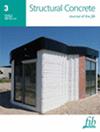钢筋混凝土外墙宽梁柱连接的抗震性能
IF 3
3区 工程技术
Q2 CONSTRUCTION & BUILDING TECHNOLOGY
引用次数: 0
摘要
本文使用七个半比例试件研究了梁柱宽度比、混凝土强度和轴向荷载对宽外墙梁柱连接抗震性能的影响。试验结果表明,所有试件的梁端都出现了弯曲破坏。核心柱的混凝土破坏并不严重,满足强柱弱梁和强连接弱构件的抗震要求。对于梁宽较小的试件,增加轴向荷载可有效减少外接缝处混凝土的破坏,提高试件强度。增加梁宽和混凝土强度在提高试件强度的同时,也降低了试件的延性。锚固在核心柱外的纵向杆件的粘结性能较差,因为在试验过程中观察到与混凝土的粘结滑移。此外,与 ACI 318-19 相比,GB 50011-2010 在计算外部宽梁柱连接处的抗剪强度时更为保守。最后,通过 MSC Marc 建立了相应的有限元模型,并根据试验结果进行了验证。本文章由计算机程序翻译,如有差异,请以英文原文为准。
Seismic performance of RC exterior wide beam–column joints
In this paper, seven half‐scale specimens are used to investigate the effects of the beam–column width ratio, concrete strength, and axial load on the seismic performance of wide exterior beam–column joints. The test results show that all the specimens undergo bending damage at the beam end. The concrete damage in the core column is not significant, meeting the seismic requirements of strong column–weak beams and strong joint–weak members. For specimens with small beam widths, the increase in axial load can effectively reduce the damage to the concrete in the outer joint and increase the strength of the specimen. Increasing the beam width and concrete strength reduces the ductility of the specimen while increasing the strength of the specimen. The bonding performance of the longitudinal bars anchored outside the core column is poor, as bond–slip with the concrete is observed during the test. In addition, compared with ACI 318‐19, GB 50011‐2010 is more conservative for calculating the shear strength of exterior wide beam–column joints. Finally, a corresponding finite element model is established by MSC Marc and verified based on the experimental results.
求助全文
通过发布文献求助,成功后即可免费获取论文全文。
去求助
来源期刊

Structural Concrete
CONSTRUCTION & BUILDING TECHNOLOGY-ENGINEERING, CIVIL
CiteScore
5.60
自引率
15.60%
发文量
284
审稿时长
3 months
期刊介绍:
Structural Concrete, the official journal of the fib, provides conceptual and procedural guidance in the field of concrete construction, and features peer-reviewed papers, keynote research and industry news covering all aspects of the design, construction, performance in service and demolition of concrete structures.
Main topics:
design, construction, performance in service, conservation (assessment, maintenance, strengthening) and demolition of concrete structures
research about the behaviour of concrete structures
development of design methods
fib Model Code
sustainability of concrete structures.
 求助内容:
求助内容: 应助结果提醒方式:
应助结果提醒方式:


